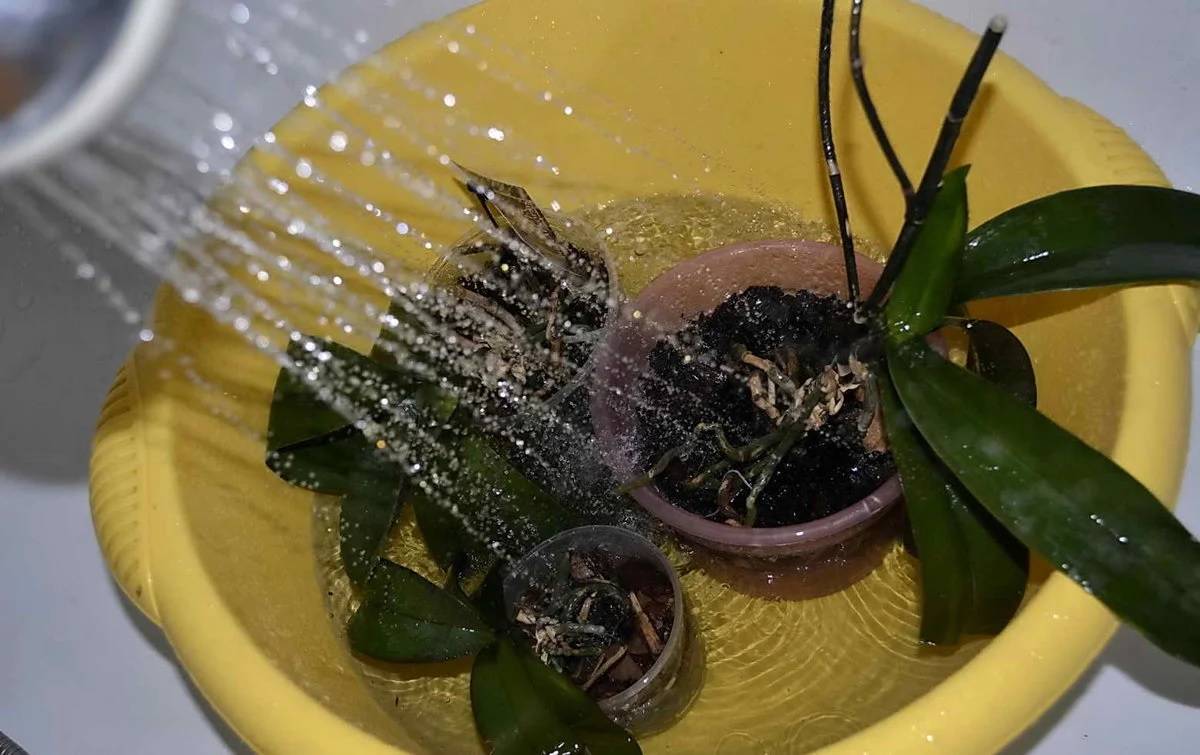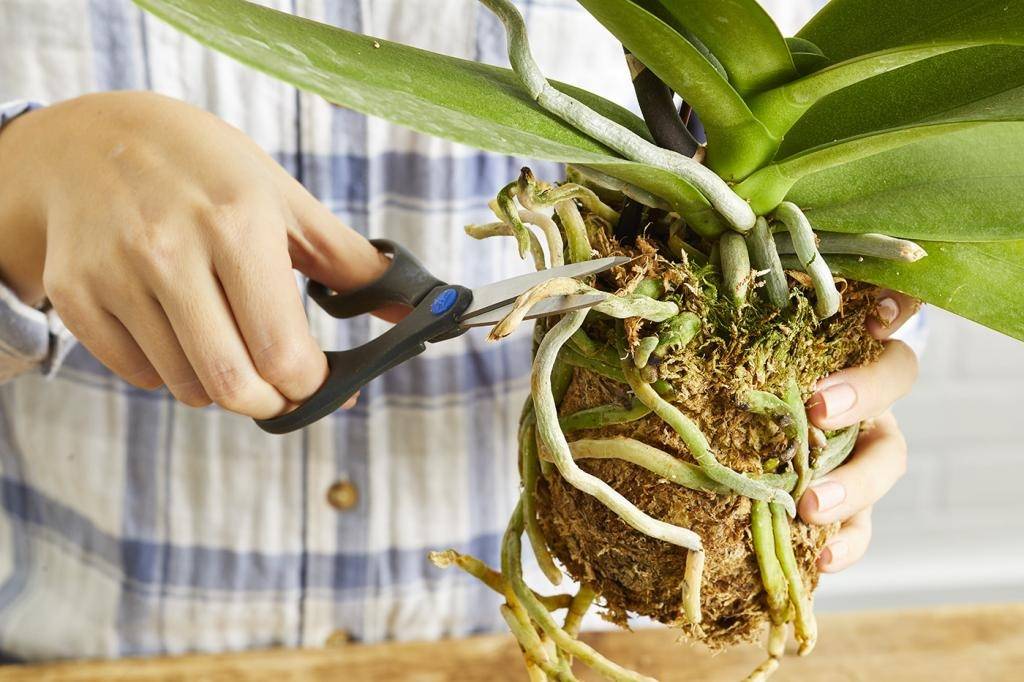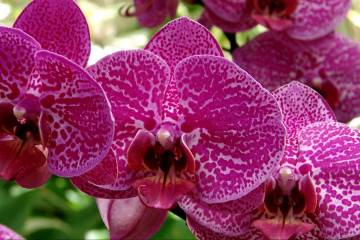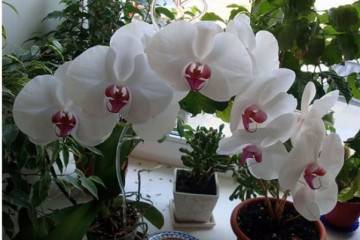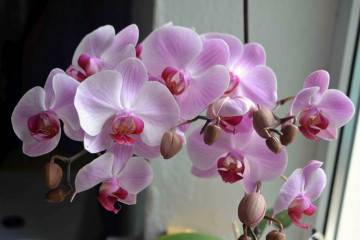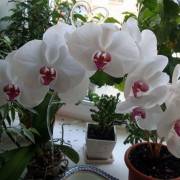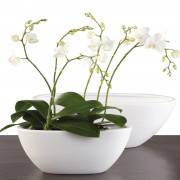How to water an orchid correctly and how often
Content:
Orchid is a plant that attracts with long and very beautiful flowering, but a tropical flower is very capricious to care for. In order for it to bloom well and not shed its leaves, many conditions must be met. These include competent watering.
How often to water an orchid
The frequency of watering can be determined by specific signs:
- do not carry out the procedure if there is condensation on the walls of the pot. If they are opaque, then the moisture level can be determined with a stick, which is immersed in the soil;
- the need for watering can be determined by the color of the roots. If they become lighter, the plant needs moisture.
Watering a tropical home plant depends on the species. Most often, the procedure in the summer is necessary no more than three times a week. In winter, the amount is reduced depending on the condition of the plant.
Water quality for orchids
It is important to know not only how to water properly, but also what kind of water it needs to be done. Water for irrigation must first be defended, it must be warm. To properly prepare water, it is passed through a filter and left for a day in a room at room temperature.
Distilled water is not prohibited. But first it is diluted with the usual one.
You can soften the water yourself at home. To do this, a handful of top sour peat is wrapped in a napkin, which must be placed in water (3 liters) and left for 12 hours. Oxalic acid can also be used to soften the water.
Signs of improper watering
It is very important to know how to water an orchid at home correctly. Both excess and lack of moisture can destroy the flower. If the procedure is performed incorrectly, the following symptoms appear:
- begin to turn yellow and take out the leaves;
- the roots turn black.
These two factors indicate an excess of moisture and root rot. If there is not enough water, the roots begin to brighten, the petals fade.
It is important not only to maintain the correct watering frequency, but also to use the optimum temperature for the plant. If it is very low, the flower may completely stop flowering.
What is the risk of improper watering
If the flower is watered incorrectly, this can lead to the following consequences:
- the plant will begin to gradually rot the roots;
- the root system will completely die, this will lead to the plant ceasing to absorb water;
- if the orchid is watered very rarely, it will experience a shortage, the leaves will begin to curl and dry out;
- the flooded plant completely lacks flowering, sometimes buds appear, but quickly fall off.
Both overflow and underfilling lead to the complete death of the flower, if measures are not taken to save it.
Features of the procedure in the cold and warm season
In winter, the amount of watering is reduced compared to the flowering period. You need to water every 10 days. But at the same time, it is important to ensure that the soil does not dry out.If the plant is watered under a warm shower, it will need to be left in the tub overnight until the excess is completely drained off.
Orchid watering technique
There are several ways to water orchids:
- immersion is the most common method. To implement it, you need to purchase a special large container in which you can place a flower pot. The container must be without drain holes. It is necessary to lower a pot with a flower into it in such a way that the water level does not reach the top by one centimeter. Then you need to leave it for 10 minutes so that the soil is saturated with water. The appearance of moisture will be noticeable on its surface. Then the pot is removed and the water is allowed to drain completely. By watering your orchid in this way, you can feed it at the same time. For this, fertilizers are preliminarily dissolved in water;
- using a watering can. This method is referred to as overhead watering. But novice gardeners need to use it with great care. Water should not get into the leaf axils. If it remains there, the process of decay will begin. You need to carry out the procedure with a watering can with a long and thin nose. The process takes place step by step. You need to pour water until it starts to come out through the drainage holes. Then for a while you need to leave the plant to rest, after five minutes the procedure is repeated;
- watering orchids at home can be done with running water, arranging a warm shower for the flower. It is an imitation of natural conditions, reminiscent of a tropical rainstorm. Running water well moistens the soil and roots, leaves are cleaned of dust, insects and pests get lost. It is often impossible to use this method. The plant should not be hot during the procedure. Water is used no higher than 50 ° C. Watering should be carried out until the soil is completely saturated with moisture. After that, the pot is placed in the shade for half an hour, allowing the water to drain. Then the leaves are wiped dry. It is very important to dry all the sinuses so as not to provoke rotting in the future.
If the flower is grown in an open way without soil, spraying can be used. This will require a spray bottle. With its help, open roots are irrigated from above.
Air humidity and spraying
In their natural environment, orchids are found in high humidity conditions. Therefore, in the apartment for them, the level is optimal, close to natural. The indicator should be between 60% and 80%. If it is lower, you can use several methods to increase the humidity:
- orchids love sprinkling with their spray bottle. But the procedure must be carried out as competently as possible. Novice growers make the mistake of spraying the plant very often. As a result, it does not have time to completely dry out, water accumulates and provokes decay. The problem is that it is not noticeable from the very beginning. Gradually, the leaves turn yellow and completely fall off. Spraying can only be carried out before lunchtime in spring and summer. In the cold season, the procedure is not recommended;
- in winter, during the heating season, dishes with water are placed near the battery. Gradually, the liquid begins to evaporate, providing an optimal level of humidity in the air;
- vases or cups of water can be placed near the plant.
The best way to increase the humidity level in your room is to use a humidifier.
Procedure if the plant is flooded or overdried
In different life cycles, an orchid requires a certain watering regime.During the flowering period, a break of up to two weeks should be organized. If the frequency is violated, then the plant will begin to rot from excess water. If the flower is flooded, you can help it only if it is transplanted into a new substrate.
The transplant process should be carried out as follows:
- The roots of the plant are very fragile, so you need to carefully remove the flower from the pot. It is recommended to cut the pot to avoid damage.
- Before planting, the plant is washed with warm running water.
- With the help of scissors, decaying parts are removed, yellow leaves are removed.
- Sections need to be treated with activated carbon in order to disinfect.
- The new pot is pre-washed using laundry soap. This is necessary for disinfection.
- At the bottom of the pot, a 5 cm thick expanded clay drainage is laid out. A substrate is poured on top, the roots of a flower are placed on it. Then they are covered with moist soil.
After transplanting the plant into a moist substrate, you do not need to water it immediately.
The wrong watering regime can also lead to an acute lack of moisture. The first sign will be a discoloration of the roots. They will become lighter. To prevent drying, you need to water the plant 2-3 times a week in hot weather, and in winter, reduce the procedure to 1 time. In a normal state, the ground should always be moist.
When the plant begins to dry out, the state of the foliage and shoots changes. They lose their howling color, become wrinkled, the edges dry out, and a yellow stripe appears. In the future, they become fragile, crumble as soon as you touch them.
Most often, a dried plant can be saved. To do this, it is recommended first of all to do the following:
- it is good to examine the flower to make sure that it has living roots;
- regularly moisten the soil.
Plants come to life well if you provide them with bottom watering. To do this, water is poured into a saucer, then a pot with a flower is placed in it.
If the orchid does not have living roots, it can be restored by building a greenhouse. This requires a 5L plastic bottle that is cut in half. Drainage is laid on the bottom, a layer of sphagnum moss is placed on top. Then the affected plant is placed there. From above, the flower is covered with the second part of the bottle. It is important to maintain a high level of moisture inside. As soon as the plant forms new roots, it can be transplanted into soil with bark.
Watering is the most important factor for long-lasting flowering and orchid health. Knowing how to carry out the procedure correctly, you can extend the life of your beloved flower.




